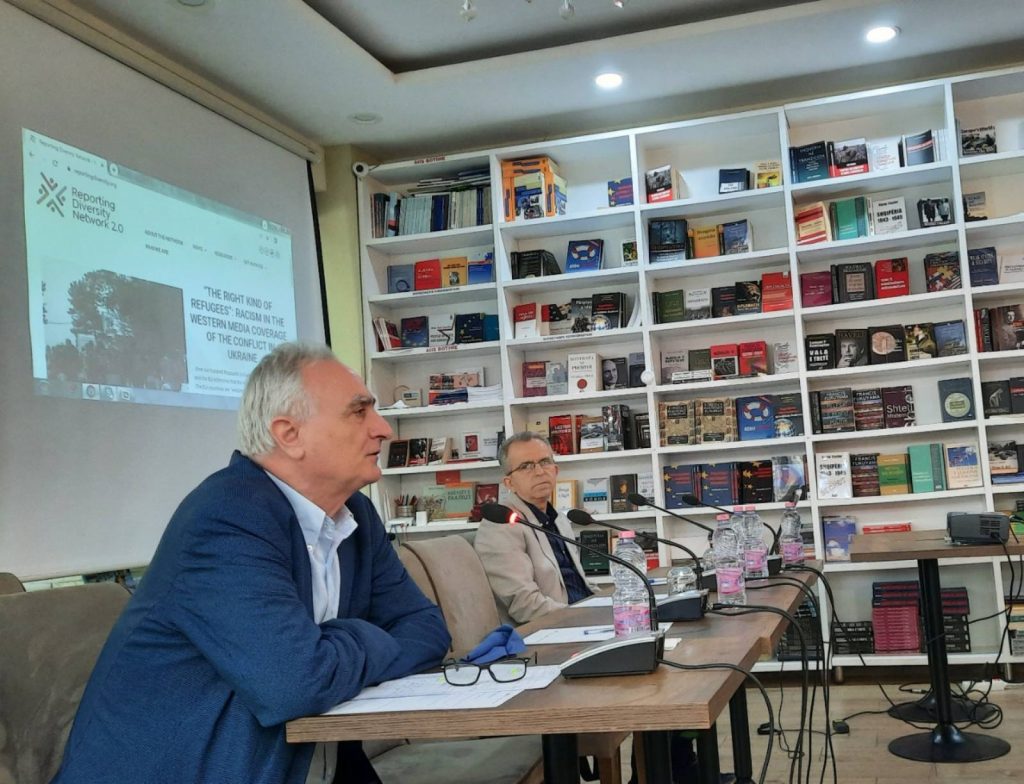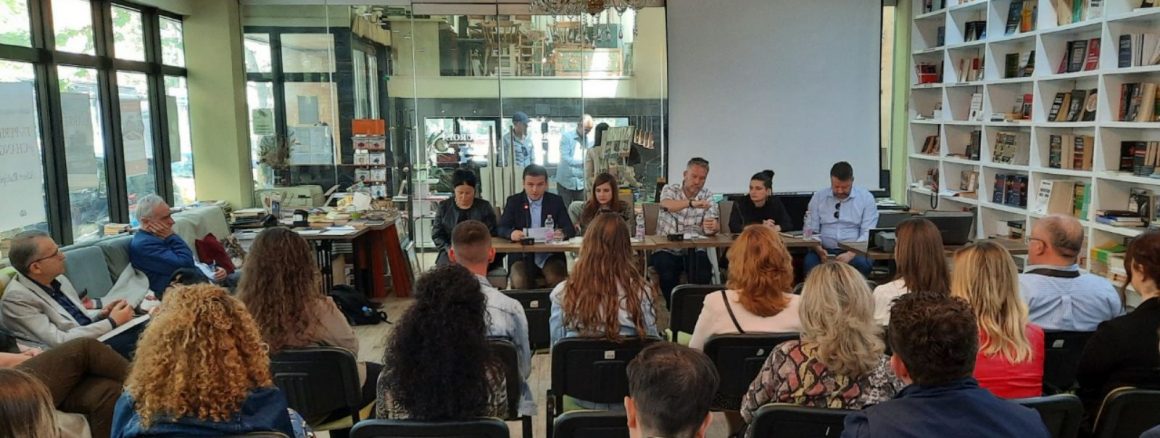Reflecting diversity in the media: why and how?
May 5, 2022
The importance of reflecting diversity in the media
On April 28th 2022, the Albanian Media Institute organized the conference: “Reflecting diversity in the media: why and how?”.
The conference took place as part of the activities of the Reporting Diversity Network 2.0 Project, which has been implemented since 2020 in Albania, Kosovo, North Macedonia, Serbia, Montenegro, and Bosnia and Herzegovina. The project aims to replace divisive narratives and hate speech mainly of ethnic, gender and religious backgrounds, thus contributing to the promotion of the values of coexistence, tolerance and good neighborliness in the region.

Reporting Diversity Network 2.0 is a continuation of the network established in 1997, at which time the First Reporting Diversity Manual was drafted and the Media Diversity Institute was established in London. The purpose of the Network is to promote accurate reporting and dignified representation in the media of diversity with racial, ethnic, gender, religious, and other, backgrounds.
The Albanian Media Institute (ISHM), as part of the Network, strives to improve the reporting of diversity in the media by pursuing a proactive approach, which means creating space for society, as it really is and looks like, to be reflected in the media. Thus, ISHM does so by embracing the fact that we are all different, we have different beliefs and opinions, different ethnicities, but we have a common right, which is to present ourselves with dignity, professionalism and accuracy in the media. As Remzi Lani, director of the Albanian Media Institute, emphasizes, “Albania needs reporting on diversity in society more than reporting on minorities, because the media has a duty to reflect the diverse world as it is, with ethnicity, religious beliefs, gender orientations, etc.”
This proactive approach was also reflected in the conference, which invited representatives of the Audiovisual Media Authority, the Commissioner for Protection from Discrimination, the Committee of National Minorities, the Center for Interfaith Cooperation, academia, civil society organizations covering target groups such as women in the media, women in science, children, people with disabilities, the LGBTQ+ community, etc. Journalists, students, teachers and representatives of youth and media organizations were also present.
The current situation of the reflection of diversity in the media
Despite the different institutions and target groups that the guests represented, they have one common concern: the misreporting of diversity in the media, which often includes hate speech, bias, offensive language, sensationalist language, derogative language, and sexism or misogyny. Prof. Rrapo Zguri stressed that “even in the mass media in Albania, animosities based on erroneous generalizations are present in the portrayal or reflection of the other or of the one who is different.”
Furthermore, other issues identified in the reporting of diversity in the media are “prejudices as a strategic form of self-reliance,” which appear in the phase of aggressive awakening and that of “dormancy.” The presence of the discourse of the majority or the “syntax of hegemony” leads to the denial of the rights of the ‘minority’ to be heard and represented in media and society. Other problematic lines of media discourse are related to religious or ethnic origin, rhetoric of ethnic, religious or regional superiority, collective instead of individual portrayal, euphemistic and ableist language, etc.
Suela Lala, from “Fondacioni Së Bashku” (Together Foundation) shared cases of inappropriate reporting on people with disabilities in the media, such as through the use of euphemisms as “differently abled,” or “special needs,” or denigrating terms such as “blind” or “deaf.” On the other hand, stories that present them at the dramatic extreme, with compassionate language or that which attributes supertalents, according to her, do not reflect reality, but stigmatize this target group and do not represent it as it really is.
Suela Musta from “Albanian Women in Audiovisual” shared the findings of the study conducted during the period May-June 2021, on women and girls in the media, who continue to remain underrepresented and misrepresented. The use of sexist language prevails, gender stereotypes are reinforced and women and girls who are victims of domestic violence or sexual abuse are blamed, while perpetrators and aggressors are justified. A sensationalistic approach and disrespect for the right to privacy also remain extremely problematic.
Reporting on religious topics also remains problematic, where, according to Sokol Lulgjuraj, from the Center for Interfaith Cooperation, the media reports in a biased manner and messages are distorted or used out of the context where they are stated. The rush to bring the latest news prompts immediate reporting and increases the risk of inaccurate reporting, non-verification of information or statements. Media outlets turn out to be selective and not inclusive in reporting on religious activities, which, according to him, occurs because “the media has no economic interest” in presenting a peace gathering of believers of all faiths.
Sead Kazanxhiu, from the Committee of National Minorities, stated that the media reports “in an exotic, prejudicial and discriminatory manner” on topics related to national minorities. He stresses that the media and journalists need to be more in-depth and professional when reporting on minorities. When it comes to reporting on minorities, “hate silence” is present, indicating a lack of reporting or representation of these groups in the media. Negligence and forgetfulness are just as harmful as misreporting.
On the other hand, Xheni Karaj, from the LGBT Alliance raised concerns about inappropriate media reporting on topics that affect the LGBTQ+ community, where it is observed that statements are taken out of context, headlines are sensationalistic in nature and television moderators and hosts are not professional and impartial during programming. All this lack of professionalism affects the spread of hate speech against the community and its particular individuals, the consequences of which can also be physical attacks or persecution in real life. “Reporting for clicks, or just a headline for a journalist in the newsroom, can turn into a nightmare in a person’s real life,” she added.
The current situation of diversity reporting in the media is obviously problematic, for all social categories without distinction. Unprofessional and unethical reporting, especially when it contains hate speech, insults, contempt and bias reinforces negative and harmful stereotypes about the “other”, whoever he/she is, creates social divisions and incites violence, which can then lead to discrimination or hate crimes.
Suggestions for improving diversity reporting in the media
In addition to sharing the current situation, the purpose of the conference was for guests to provide suggestions for improving the reporting of diversity in the media. Thus, Arben Muka, from the Audiovisual Media Authority, stressed that, in addition to reviewing complaints and content, an effective approach is to promote information and awareness on proper diversity reporting, as well as to encourage self-regulatory engagement. The fine against media service providers, as a punitive measure provided by law, does not always give the expected result, as the same violation may occur again by the same subject. In this case, education rather than punishment seems to be the most promising approach, although what this education/literacy involves and how it is enforced concretely in cases of violations of the code of ethics of journalism, remains to be clarified.
On the other hand, Robert Gajda, Commissioner for Protection from Discrimination, stressed that a good practice of improving the reporting of diversity in the media is the “immediate response” right after an incident or a misreporting has occurred. According to him, a timely reaction provides an opportunity to correct the news without going viral and without causing “greater harm,” as well as due to the fact that it is more effective in real time.
Regarding the representation of women and girls in the media, Blerjana Bino from the Center “Science and Innovation for Development” (SCI-DEV) & Network of Albanian Women in STEM, emphasizes that the presence of women in STEM in the media should be increased and a proactive approach should be followed to the identification and provision of media space. Education/literacy and awareness, as well as monitoring and responses remain active forms of improving media reporting of women and girls. Suela Musta, meanwhile, emphasizes that the new Broadcasting Code should pay special attention to sexism and misogyny in audiovisual media, with the aim of reducing them as much as possible.
Suela Lala says that improving reporting on people with physical, sensory and mental disabilities can be improved by avoiding the use of euphemisms, reporting in a balanced, non-sensationalistic way, as well as by reporting from a human rights approach rather than from a defensive approach that presents them as categories to be pitied.
In conclusion, other practices for improving media diversity reporting are immediate social and media responses, through reporting or public statements; taking stronger measures against national televisions which use television space to reinforce negative stereotypes, sexism, misogyny or denigrating language towards different social groups; large-scale media literacy for all age groups, as well as reports and complaints to the “Complaints Council” or the “Alliance for Ethical Media.”
